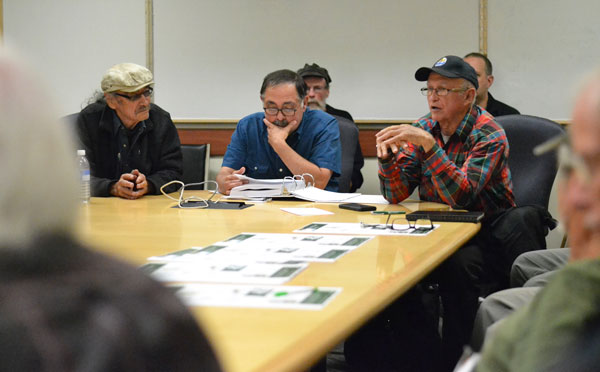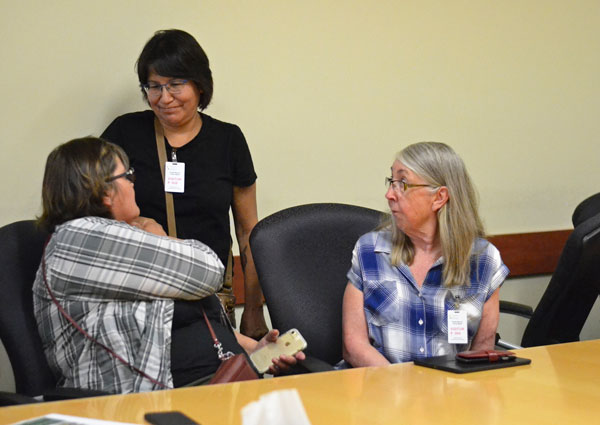
“We all have an air addiction…we need it. It has to be protected.”
– David Rondeau
Around 30 people gathered in Prince Albert’s Forestry Centre on Tuesday to discuss their concerns with provincial government representatives about clearcutting forests.
Clearcutting, as the name explains, is cutting down every tree in an area. Those who attended the meeting were passionate that the logging practice should not be happening to the area’s forests.
The concerns stem from a 20-year plan from Sakâw Askiy Management that was released last year. The corporation—which is monitored by the provincial government—plans to harvest millions of hectares of forest, including the trees surrounding Ness Creek and Nesslin Lake.
Mark Doyle, forest management planning coordinator with the Ministry of Environment, said it’s also required that Sakâw Askiy submits an annual report describing how the plan is going.
Area Forester Chris Brown was also at the meeting, where people voiced several concerns including global warming and harm to Indigenous culture and wildlife.
The entire room seemed to be shaken by Sylvia McAdam’s Indigenous perspective.
She and her brother, Kurtis McAdam, are the founders of Idle No More.
“I’ve been picking sweetgrass all my life. I know the feel of the land. It’s harder to pull the sweetgrass out. The ground is so dry, even when it rain, rain, rains. The past few days it’s been raining. I got out there and the next day the ground’s already dry,” she said.
“You either support Indigenous peoples or you’re just going to keep barrelling down the same road that didn’t work for your lands in Europe over there. And that same ideology was brought over here that’s going to destroy every damn one of us,” she said, speaking to the government.
When McAdam left mid-meeting, she was showered in hugs. Doyle shook her hand.

David Rondeau represented Métis Local 66 in Crutwell.
“My concern generally is the lack of information on this clearcut. I don’t feel that the public was informed. As you can see, the turnout here is not that great…Where’s the young people? Where’s the youth? Where’s the future?” He asked.
Several people brought up global warming, which Doyle and Brown said they couldn’t address because it’s not in their field.
“I don’t like that term, global warming, because I don’t think people are going to listen until it’s turned to global burning,” emphasized Rondeau.
“We all have an air addiction…we need it. It has to be protected and I think if more people know about it, the more that can be done.”
The need to have more people informed was echoed by Bryan Lee, who organized the meeting. He’s the president of the Fish Lake Métis.
“We the citizens need to have a voice. It should not be left up to just government and industry to make the decisions as to what’s happening to our forests by way of clearcutting,” he said.
Lee said most people who came to the meeting feel there needs to be a moratorium—a temporary ban—on clearcutting.
Speaking to media after the meeting, Brown said forests are managed with modified clearcutting. The intent, he explained, is that it will mimic natural disturbances such as fires and leave patches of trees.
A new environmental code released by the ministry a few years ago directs forestry operations to retain the kind of texture left by a wildfire.
According to assistant deputy environment minister Kevin Murphy, a traditional boreal forest will have a majority of trees found in the youngest ages and the least amount in the oldest forest ages. Those forests are shaped by natural disturbances, such as fire, insects and disease.
During a meeting in Prince Albert this past April, Murphy spoke about the importance of logging to ensure that natural pattern of disturbance.
“Forest management in Saskatchewan is designed to result in a forest age structure that emulates natural disturbance to maintain a natural range of ecosystems,” Murphy said.
“Within the boreal shield ecozone, where fire suppression has been less intensive, forests typically follow the natural age distribution.
“Within the boreal plain ecozone, where most of the commercial forest zone resides, protection from fire, insect and disease has been a priority over the last six decades. The proportion of mature and old forest ages are high relative to what is expected. Since older forests can lead to more intense wildfires and more serious insect infestations, the two options to address the age imbalance are to let wildfire play a more natural role when safe to do so or to carefully plan forest harvesting that emulates disturbance. We do both.”
On Tuesday, another concern Brown responded to was having only four staff looking over Sakâw Askiy’s management area. He said others assist in overseeing them as well, such as conservation officers, and that over 20 staff do inspections on forestry companies.
“We do rely on tips from the public as well, so if people see things that are happening on the ground that concern them or they think that maybe (there is) a contravention of an act or a forest management plan, absolutely, we want to hear those things so we can go have a look at them.”
Brown emphasized his own passion for the province’s forests.
“I became a forester because I want to ensure forests are managed in a sustainable manner. I have no desire to liquidate forests, to de-forest forests,” he said.
“I see the passion, and the more information that we get from folks, the more informed decisions we can make.”
He said the forest service will have to sit down and discuss the concerns that were voiced at the meeting.
You can find Sakâw Askiy’s Forest Management Plan (FMP) on their website.

